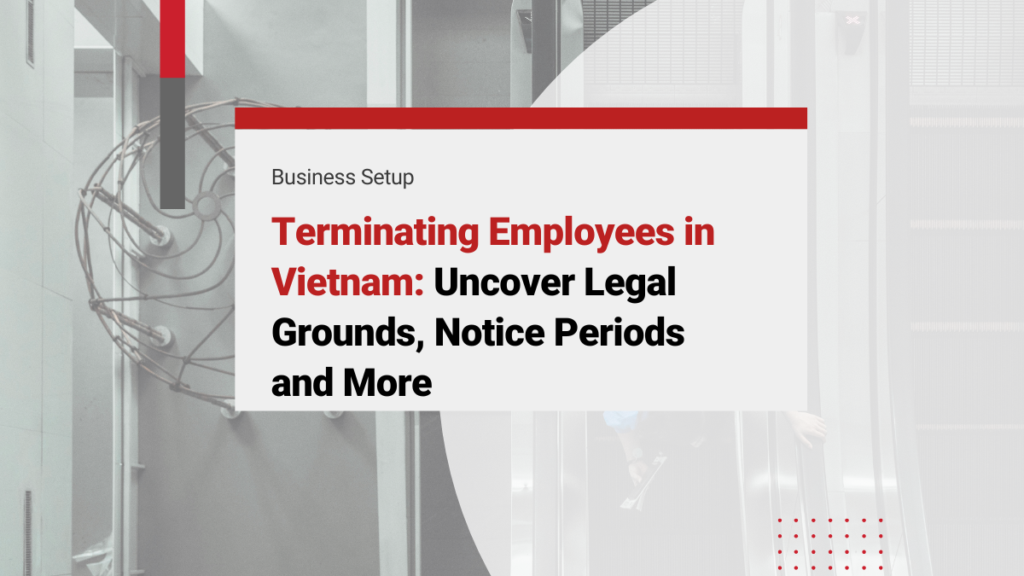Terminating employees in Vietnam requires careful navigation of complex labor laws designed to protect employee rights while enabling legitimate business needs. Understanding the legal framework, proper procedures, and recent updates is essential for foreign employers operating in Vietnam’s evolving regulatory landscape.
Legal Grounds for Termination in Vietnam
Under the 2019 Labor Code, employers can only terminate employment contracts based on legally recognized grounds. The law provides 13 specific circumstances for contract termination, which fall into several categories:
Read more: Vietnam Labor Law & Labor Code: A Guide for Businesses
Mutual Agreement and Contract Expiration
- Expiration of the labor contract term: When the agreed duration of the labor contract ends, the employment relationship concludes unless both parties agree to renew or extend the contract.
- Completion of work specified in the contract: If the employee finishes the specific job or project outlined in the contract, the employment ends upon completion.
- Mutual agreement between both parties to terminate: Both the employer and the employee can agree in writing to end the contract at any time, regardless of its original term. This is often used for amicable separations and should be documented to avoid disputes.
Employer-Initiated Termination
Employers in Vietnam can only terminate employees on certain legal grounds, and must follow strict procedures:
- Poor performance: Employee repeatedly fails to meet job requirements as defined in the company’s assessment criteria.
- Restructuring or economic reasons: Organizational changes, technological updates, or economic downturns necessitating workforce reduction.
- Illness or injury: Employee unable to work after extended treatment periods (12 months for indefinite contracts, 6 months for fixed-term contracts).
- Force majeure: Natural disasters, epidemics, or other circumstances beyond employer’s control.
Disciplinary Dismissal (Immediate Termination for Serious Misconduct)
Immediate termination without notice or severance is permitted for serious misconduct, including:
- Theft, embezzlement, or gambling at the workplace
- Disclosure of trade secrets or intellectual property violations
- Sexual harassment or violent behavior
- Excessive unauthorized absences (5 days within 30 days or 20 days within 365 days)
Automatic Termination
Certain situations result in the automatic end of the employment relationship, with no need for notice or further action:
- Employee reaches retirement age with sufficient social insurance contributions
- Employee is sentenced to imprisonment or death penalty
- Employee or employer dies or is declared legally incapacitated
- Foreign employee is deported or work permit expires
Note: Each ground for termination requires strict adherence to the procedures and documentation set out in Vietnam’s Labor Code to avoid legal risks and potential disputes. Employers should consult legal experts or HR professionals to ensure compliance at every step.

Notice Periods and Requirements
Vietnam’s Labor Code mandates specific advance notice periods depending on contract type and termination reason:
| Contract Type | Notice Period |
| Indefinite-term contracts | 45 days minimum |
| Fixed-term contracts (12-36 months) | 30 days minimum |
| Fixed-term contracts (under 12 months) | 3 working days minimum |
| Disciplinary dismissal | No notice required |
Important 2025 updates: The recent amendments emphasize that notice must be provided in Vietnamese, with supporting documentation clearly stating termination reasons and effective dates.
Special notice considerations:
- Pregnant employees, those on maternity leave, or sick leave cannot be terminated during protected periods.
- Trade union consultation is mandatory for certain terminations, particularly those involving misconduct or economic restructuring.
- Written notice must include specific legal grounds, termination date, and final payment details.
Severance Pay and Final Compensation
Employees with at least 12 months’ service are entitled to severance pay if terminated under most conditions. The general formula is:
| Formula: Severance Pay = 0.5 × Average Monthly Salary × (Years of Service – Unemployment Insurance Period) |
Key components:
- Average Monthly Salary: Based on the last 6 months before termination
- Years of Service: Total employment period minus unemployment insurance-covered periods
- Rounding Rules: 6+ months rounds to 1 year; less than 6 months rounds to 0.5 years
Enhanced compensation applies for redundancies due to restructuring, technology upgrades, or economic downturns:
- Employees receive at least one month’s salary per year of service (minimum: two months’ salary).
All compensation must be settled within 14 working days; this may extend up to 30 days if there is a mass layoff or company closure. Disputes over severance have increased by 15% year-over-year, mainly due to miscalculation of deductions for unemployment insurance.
Step-by-Step Termination Process
Step 1: Document Valid Grounds
Before proceeding with any employment termination, the employer must identify and document valid legal reasons as outlined in the Vietnamese Labor Code. This includes reviewing the employment contract, company internal labor regulations (ILRs), and gathering relevant evidence – such as written warnings, performance reviews, or medical records. Each reason for termination must clearly align with one of the lawfully recognized grounds, like poor performance, restructuring, or serious misconduct.
Step 2: Consult Trade Union (if applicable)
In cases where the termination involves disciplinary action or organizational restructuring, employers are legally obligated to provide advance written notice to the grassroots trade union (or employee representative organization). Employers must also submit documentation explaining the reason for termination. The trade union’s written opinion is not binding but must be obtained before proceeding. Failing to complete this step can invalidate the termination.
Step 3: Prepare Termination Documentation
Termination documents must be prepared in Vietnamese, as this is the legally recognized language. The termination notice must clearly state the legal grounds, specify the effective date of termination, and provide a detailed breakdown of final payments due to the employee, including outstanding salary, unused annual leave, and severance pay. Accurate calculations and lawful formatting of documents reduce the risk of post-termination disputes.
Step 4: Provide Required Notice
The employer must issue a formal termination notice based on the type of employment contract:
- 45 days for indefinite-term contracts
- 30 days for fixed-term contracts (12–36 months)
- 3 working days for short-term contracts (<12 months)
The notice must be presented in writing. Employers should ensure the employee signs to acknowledge receipt and must retain a copy of the notice for legal compliance. It’s also best practice to record and document all related communications.
Step 5: Conduct Final Settlement
Within 14 working days of the termination date, the employer must settle all payments owed to the employee. This includes:
- Unpaid salary
- Unused annual leave
- Severance or redundancy compensation
- Social insurance book and personal documentation
If the company faces special circumstances, such as a restructuring or closure, this period can be extended up to 30 days. Employers must also complete the issuance of a work confirmation certificate (if requested by the employee), as required under Vietnamese labor law.
Step 6: Update Official Records
After completing the termination and financial settlement, employers must update the company’s official records with relevant authorities. This includes:
- Informing the Social Insurance Department of the employee’s departure
- Updating the unemployment insurance database
- Notifying the Tax Authority of payroll changes
- Submitting relevant termination reports to the Department of Labor, Invalids, and Social Affairs (DoLISA)
Timely updates help ensure compliance and avoid inspections or fines for failing to properly register employee status changes.
By following this detailed, legally compliant process, employers reduce the risk of wrongful dismissal claims and demonstrate an active commitment to fair employment practices in Vietnam.

Preventing Wrongful Termination Claims
Ensuring compliance and mitigating legal risk are crucial when terminating employees in Vietnam. Here’s how employers can avoid common mistakes and follow best practices, including special protocols for foreign employees.
Employers must be vigilant to prevent legal challenges and claims:
- Incomplete documentation: Always keep thorough records of performance issues and disciplinary measures.
- Ignoring procedures: Adhere strictly to notice periods and mandatory union consultations before termination.
- Discrimination: Never terminate based on gender, pregnancy, union membership, or personal beliefs.
- Timing errors: Avoid dismissals during protected periods like maternity leave, sick leave, or quarantine.
Best Practices for Compliance
To minimize risks associated with wrongful termination, employers should:
- Establish clear, well-defined regulations for performance standards and disciplinary procedures.
- Train HR personnel regularly on lawful termination steps.
- Maintain bilingual records – Vietnamese documents are considered legally binding.
- Consult legal advisors for complex cases, especially those involving foreign staff.
Fact: In 2025, workplace inspections related to termination have risen by 25%. Non-compliance can result in fines ranging from VND 1,000,000 to VND 50,000,000.
Special Considerations for Foreign Employees
When handling the termination of foreign employees, employers have extra administrative obligations:
Work permit revocation:
- Notify labor authorities within 15 days of the employee’s termination.
- Return the revoked work permit to the issuing agency.
- Provide all relevant paperwork, including the termination decision and contract details.
Read more: Work Permit in Vietnam: Requirements, Procedures & Services
Residency card procedures:
- Inform immigration authorities when sponsorship ends.
- Retrieve and return the temporary residence card.
- Assist the employee with departure, if necessary.
Social Insurance:
- Stop social insurance contributions immediately after termination.
- Issue all required certificates to support a one-time pension claim if the foreign employee leaves Vietnam.
Read more: Vietnam Social Insurance: Social, Health & Unemployment Insurance (SHUI)
Handling Company Property and Exit Procedures
Careful management of company property and thorough exit procedures are essential to minimize risk, protect assets, and maintain compliance with Vietnam’s labor laws during employee termination. Clear protocols ensure a professional departure process and protect both employer and employee interests.
Asset Recovery Process
- Inventory creation: Document all company property assigned to employee
- Return procedures: Establish clear timelines for property return
- Access revocation: Immediately disable system access, building entry, and company accounts
- Final inspection: Conduct thorough review of returned items
Exit Interview Protocol
- Confidentiality reminders: Reinforce non-disclosure obligations
- Knowledge transfer: Ensure proper handover of responsibilities
- Feedback collection: Gather insights for process improvement
- Reference provision: Clarify reference policy and procedures
Digital Asset Management
With increasing digitalization, 2025 guidelines emphasize:
- Data protection: Ensure employee personal data is handled according to privacy regulations
- Account closure: Properly terminate access to digital platforms and services
- Intellectual property: Confirm transfer of work-related digital assets
How InCorp Vietnam Can Help?
Terminating employees in Vietnam in 2025 demands careful attention to labor laws, meticulous documentation, and respect for protected employee rights. The evolving regulatory climate is unforgiving of mistakes, and non-compliance can lead to costly disputes and penalties. Employers, especially foreign companies, should prioritize legal compliance and diligent process management when handling dismissals.
Staying compliant with Vietnam’s labor policies, regulations, and procedural updates can be overwhelming, particularly for foreign companies new to the country’s unique employment landscape. InCorp Vietnam offers tailored HR and payroll support, ensuring your business navigates complex termination procedures with confidence and full legal compliance. By partnering with our expert team, you gain peace of mind and avoid costly errors, allowing you to focus on your business growth. Let InCorp Vietnam be your trusted advisor for seamless, compliant, and professional HR management in Vietnam.
For more details, explore our services at vietnam.incorp.asia.
Learn the Right Setup for Business
Expansion in the Vietnam
Frequently Asked Questions
Can I terminate an employee during their probation period?
- Yes, but proper notice must still be provided according to contract terms. Probation clauses must be explicitly stated in the signed labor contract to be enforceable.
What happens if I don't provide the required notice period?
- Employers face legal consequences including reinstatement orders, back pay for the notice period, and potential compensation claims. The employee may also file complaints with labor authorities.
Are foreign employees entitled to the same severance pay as Vietnamese employees?
- Yes, foreign employees working under Vietnamese labor contracts receive identical severance entitlements as local employees, provided they meet the 12-month service requirement.
Can I terminate an employee for poor performance without prior warnings?
- No, employers must demonstrate repeated performance failures against established criteria and typically must provide opportunities for improvement before termination.






